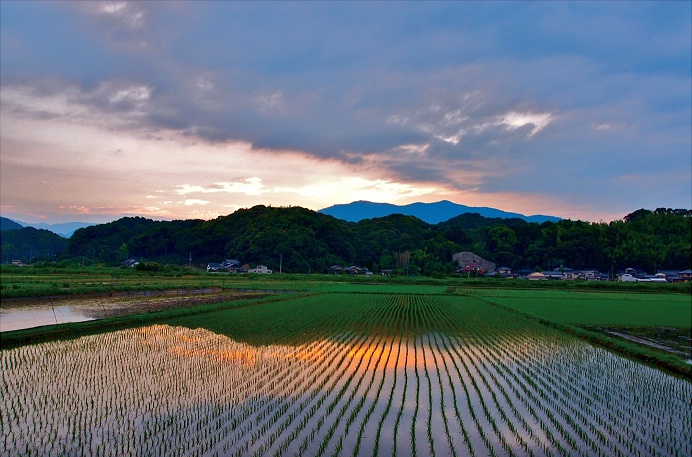Chapter 22. Chapter 22: Agriculture: Raising Crops
What are the benefits and drawbacks of industrial agriculture?

Guiding Question 22.2
What are the benefits and drawbacks of industrial agriculture?
Why You Should Care
Did you know that 90% of the world's food comes from just 15 plant species and eight animal species? What’s more, 50–60% of the world’s food comes from just four plant species: corn, rice, wheat, and potatoes. Should that concern you? Probably. Almost all of the “big four” crops and many of the other important food crops are grown with industrial agricultural methods. Industrial agriculture involves high-yield varieties of crops, newer and more-automated cultivation techniques, and synthetic fertilizers and pesticides. This all leads to more food being produced per hectare than had ever been imagined just a few decades earlier.
So, why isn't producing enough food for the world to eat a good thing? It has come with hidden costs. Modern agriculture causes many environmental problems: depleted or contaminated ground and surface waters, degraded soil, high use of non renewable fuels, and a loss of biodiversity. Growing only a few varieties of a few species makes our world crops more at risk from pathogens and predators. This has already happened: The Irish Potato Famine, for example, resulted from too many people relying on one variety of one crop and killed more people than died in the United States' Civil War.
Perhaps the most troubling drawback of industrial agriculture is its uncertain impact on our future. The high-calorie, low-nutrition processed foods that are linked to the global obesity epidemic didn't become widespread until industrial agriculture made crop surpluses such a common occurrence. The spread of obesity threatens to shorten lifespans and impair health worldwide. Turning food production into a corporate business operation rather than a local one means that many people no longer have an understanding of where their food comes from or the environmental impacts of farming. Lastly, there's the issue of the burgeoning global population. A famine may have been avoided over 50 years ago, but did increased food production let human population growth continue unchecked and set us up for an even more catastrophic food shortage in the coming decades?
Question Test Your Vocabulary
Fill in the blank with the correct term for each of the following definitions:
1. A B5kUxXHg4zwRpU6oJTNqAw== is a farming method in which one variety of one crop is planted, typically in rows over huge swaths of land, with large inputs of fertilizer, pesticides, and water.
2. 6phlWA0M9YcS9lvsXHLkSZt54B5q92ihFfXUCA== is nutrient enrichment of an aquatic ecosystem that stimulates excess plant growth and disrupts normal energy uptake and matter cycles.
Question 22.1
JP+8jWBwFFmxew2mrUO0HvAJZF5O46CAcev/TqZxPSXAjkCojVE4XepNtN1PJh9Tkhh2j1U+2qm0YG5MRXX8YbSsgD7Igjry5xlrWt9akLm55CLkJCZoQMkVPS8HMe4y8E2IXKeNzVMF3IP+GQvalnXmn87oTnWlC0S0VXkhKXh9X12IbjMs4jYhJcgqHs1JdSqWbfBV+W/aC9HSc94e90Dm3o1Y4VgFhDdlUdgYyH/CGSmDW1Q+WM8CvJsD4EXrPTHPhAmiISG29xdPE8v3A3sqwUcMfr4nv6ktYDFGU51ZAghOkgR6ezE0zR0wFFclos20AFjk44IETwfFa2+huaLzN7cjtm9TumJhLK5nr1U=Question 22.2
DbRzrDprZwgEWtSBZYGCB9+vNFa2bHbZb4tjnmrB1o0fmI2BvERKbtgcvpiXo//inMY+t7fNwhNlxFeY+DkSataoZOKiscNWk+mHEtoC95RLz2OiX+AOyiI3J76LkNjVkE/ZwPAUpvqk6d6NWlh1W6Rtx5EBgtO+kl6Lf/y/6phjwd/Q6KJ7weyQoU6PeDbtaHdm05eKkB/1NsXFCeXJBhOMKnCLkJ+nSQqw5NZDcwvZq7+KIGV6loh2yx1DXBUXXRihtnXeyrsizdzfQuestion 22.3
zbT6bragKM30YI9Vey94Xi3saHZY5lFRH9kcP1vQ+C+WNiSf6otpbrwgNEKykjUisBu3m11kQ+8gqW60cZjlnVFODl8FXls9sOX5ByHe332iuk2sWxzHgQzqKbT6BMBVAmMkG8eYXm+rDdjMQiyaEwAg04jAHgosbldESAn86iQWTk7JJmTY4p9Z5YbfrjObRyZHw5ODxRML+L8dmFpey1TdJVqn/50HV8D5zjhZ62uVyRevkhnEXAzn6l5DYHuCXUwoqEAAQoIYRuWBjeNjOaJpfUTz832S5ebL8+VyGYv+X+INe4uPKb+GZiu8viikQuestion 22.4
rLYXwJqA5eJUk4Zq6EI+eszYSZ9QHh7yje5tl56hx5cJcPwzzR8GxFxCKS9Kv2KvP/zYmB+4utTD8sMISsuu+iIl0bJ7atgWjzIMAIVtjJvXUbT0w9QaNkNMLvK7ifSwbKdU4GyS018BSRf2CN518W8h9IlfYcV7lbxriyZGshw9Pokt/4mAjSPVy8sZqZT583CotDvZZoSC7Zi+ZfzbxzkagIxT4TP9b+EIylHiC+BnT/ILZfXhx0iF4EunbvndPuOKCpa964i2xF9LXOqn1FXZaYt3InhcYfgSC834ZtTrqea4wr5bF8BsOFVncu2wHGr6cmd2YcXnbGSXA hint about reading biology: It is often helpful to learn common combining forms (for example, suffixes) of words to help you decipher meanings. Many times, if you can determine from context what one word means, you will have an easier time deciphering other words that share combining forms. Let’s look at the words “pesticide” and “herbicide.”
Question 22.5
J3ycvI7sKnyxHZaBaziTc+5l/RQZ8hhWLSXgPf2qeepK2uyVHIezbHN8Rzpwx82HIuJVgyIHwPWpITn4zAabPrWDg+84bN1iKY0SFjqydoZlFbQhvXJchOuXFl8y20CfI97LWSwapvutXDsUudLidR3TbWMCwt7e6En1J8Mv4xuag7d7MGBEF7n1DzRKm4gZ58WIJfMEpB8=Question 22.6
F31cwbSNUdQJBN85fOn+ikDMOtUkATfqrGu7HfilY3Ji/j7g7EPjDZH/P2eSrnLd+zlVMY34XMNUMtF9o+zs2JA5d2KnPvU52Mf6U2imYXlEZpbYlKf2gkxS5ONNKBV/IAQivRKKfGQkDlTBQ3Ijdz2eV/bDSMKGUxcrZSnhQ8M6FJRknnMkKhdOxCGa1bdhAvBhY0zvvPwGTkZ/5hJipw==